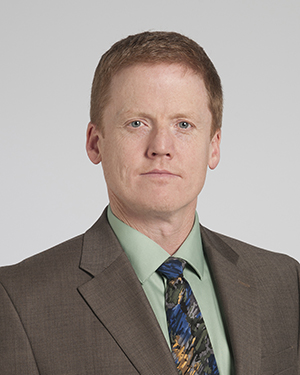Research News
11/01/2021
Using Virtual Reality to Understand and Develop Treatments for Symptoms of Parkinson’s Disease
In this three-year clinical study, Drs. Alberts and Baker will utilize virtual reality technology to isolate the causes of freezing of gait, a debilitating symptom of Parkinson’s disease, thanks to support from the Michael J. Fox Foundation for Parkinson’s Research.

Cleveland Clinic neurological researchers have received a $2 million grant from The Michael J. Fox Foundation for Parkinson’s Research to study a common symptom of Parkinson’s disease called freezing of gait (FOG), which is currently untreatable. The study is led by Jay Alberts, PhD, Department of Biomedical Engineering, and Kenneth Baker, PhD, Department of Neurosciences.
Freezing of gait prevents PD patients from initiating movement, thereby “freezing” them in place. It is a leading cause of impairment in PD, and the main reason some patients cannot care for themselves and must transition to dependent care facilities. Since FOG usually occurs while individuals with PD are performing activities of daily living, it is rarely observed in a clinical environment.
“One of the challenges of FOG is that patients will have an episode while they are multi-tasking or trying to negotiate a tight space,” said Dr. Alberts. “This has an obvious effect on their quality of life and activities of daily living. We designed a study environment in virtual reality to recreate these situations so that we can identify the brain activity leading up to FOG events and, ultimately, develop an effective treatment.”
Navigating a “virtual” world
As part of the study, the researchers will utilize a virtual reality system in combination with an omnidirectional treadmill, which allows users to walk in any direction and perform turns. Combining virtual reality and the omnidirectional treadmill fuses the real and virtual worlds, enabling participants to physically navigate through a virtual world.
Toward that end, the researchers developed a number of virtual environments, including a grocery store simulation. The shopping module places patients in a virtual grocery store and tests their ability to physically walk through the virtual aisles and pick out items on their list.
While patients are completing these tasks, the researchers will monitor the activity within an area of the brain that is affected by Parkinson’s disease and involved in skilled movements, called the subthalamic nucleus.
Drs. Alberts and Baker hope to identify an area within the subthalamic nucleus that will respond to deep brain stimulation (DBS), a leading treatment for PD. Deep brain stimulation is a surgical procedure in which electrodes that deliver electrical impulses are implanted in the brain. The impulses block or change the abnormal activity in the brain that causes the movement symptoms.
Creating a new PD treatment paradigm
Fifteen PD patients between the ages of 40 and 80 who will be receiving DBS treatment will take part in the three-year study. Patients will complete the virtual reality modules while on and off their antiparkinsonian medications. After the study is completed, the researchers will create a DBS approach specifically to treat FOG.
“Through this study we’re hoping to create an entirely new paradigm for treating PD and FOG,” said Dr. Baker, who is an expert in neuromodulation and involved in multiple DBS projects at Cleveland Clinic. “By learning what triggers FOG and identifying its neural signature, we will be able to better utilize DBS to effectively treat it.”
Featured Experts
News Category
Related News
Research areas
Want To Support Ground-Breaking Research at Cleveland Clinic?
Discover how you can help Cleveland Clinic save lives and continue to lead the transformation of healthcare.
Give to Cleveland Clinic
